Chemistry of Mesoscopic Systems
The Faust group at the University of Kassel has a physical-organic orientation and investigates issues related to chemical solar energy conversion with functional organic molecules. Relying on methods of modern organic synthesis we explore the chemistry and the photophysics of phthalocyanines and their synthetic analogues and are synthetically modifying them for an engagement in energy and electron transfer processes. To this end, we prepare (often inorganic-organic) hybrid systems with relevance to, inter alia, dye-sensitized solar cells, photocatalytically active construction materials and biosensors.
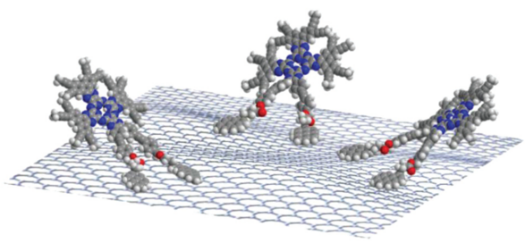
Non-Covalent Graphite Exfoliation with Pyrene-modified Porphyrazine-Derivatives
Due to its unique optoelectronic and mechanical properties, graphene is currently under extensive research interest. The liquid-phase exfoliation of graphite evolved as a yield- and cost-efficient method for the production of high quality graphene monolayers. Aromatic building blocks such as pyrene derivatives, that feature strong affinity toward graphene via π-π-stacking, have shown to assist in the exfoliation process and in the stabilization of the exfoliated material. The additional combination with photo- and redoxactive chromophores like phthalocyanines (Pc) leads to nanohybrid materials with enhanced light harvesting and photoinduced charge transfer features.
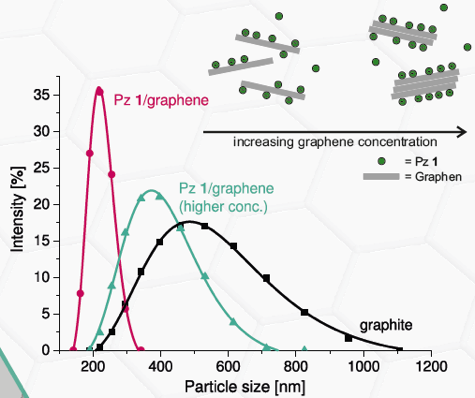
We have prepared a pyrene-functionalized tetrapyrazino-porphyrazine (Pz) with a core proven to be an efficient electron acceptor in supramolecular conjugates and explored its graphite exfoliation abilities. The presence of pyrene is vital to non-covalently immobilize porphyrazines onto the basal plane of highly exfoliated graphene leading to thicknesses of 1 to 2 layers. At least equally important is porphyrazine itself, as it p-dopes highly exfoliated graphene. From dynamic light scattering measurements we conclude the presence of 200 nm large flakes in suspension, which fold and re-aggregate once drop-cast onto Si/SiO2 wafers.
Due to this morphology Raman measurements provide evidence for the presence of mainly turbostratic, few layer graphene. In transient absorption measurements, charge separation from graphene to the immobilized electron accepting porphyrazine has been confirmed as the major deactivation of the excited state.
Reference
Bingzhe Wang, Verena Engelhardt, Alexandra Roth, Rüdiger Faust* and Dirk M. Guldi*: “n- versus p-doping of graphite: what drives its wet-chemical exfoliation?”, Nanoscale 2017, 9, 11632.
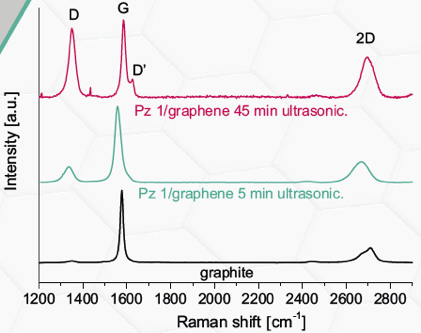
Molecular Wires with pyridyl anchor groups.
Molecular wires are organic structures that have good conductivity and can therefore serve as elementary building blocks for nanoscale devices. At least partial conductivity is usually achieved by an extended conjugated π-system. However, the wire also requires a so-called anchor group with which it binds to the metallic contacts of the device, in most cases gold. The most commonly used anchor group for gold contacts is a thiol, partly because of the strong sulfur-gold bond. An alternative anchor group is pyridine. Pyridine has the advantage that it is stable under ambient conditions and does not require protective groups. We have synthesized molecular wires that employ pyridines as anchor groups with phenyl substituents in the meta positions. The phenyl groups lend additional solubility and stabilization to the molecular wires. The rigid backbones of the wires are formed by oligophenylene or phenylethynyl, respectively. The pyridine-capped molecular wires have N-N-distances between 1.60 (in 1) and 2.93 nm (in 5), respectively.

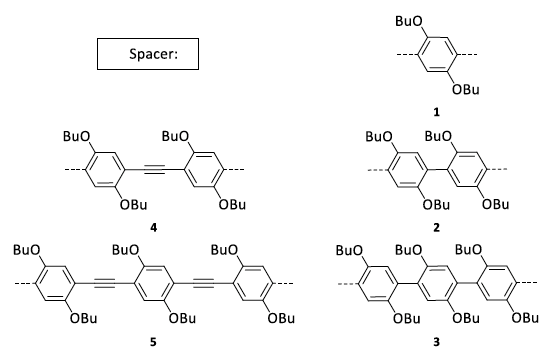
The interaction between the molecular wires and the AuNP suspended in water was investigated using the phase-transfer of the nanoparticle into a DCM Phase. To this end, we dissolved 0.33 µmol of the wire 1-5 in 7.5 mL ethanol and added them to 50 mL of a 12.5 µmolar aqueous suspension of AuNP. After a short time, the resulting particles were extracted from the aqueous phase with 10 mL DCM.
DLS measurements confirm that the binding of the wires to Au takes place via the pyridine nitrogen atom. Only pyridyl-capped molecular wires are able to extract AuNPs into the organic (lower) phase. It was also found that longer wires have a reduced binding potential because more AuNP remain in the aqueous phase (data not shown).
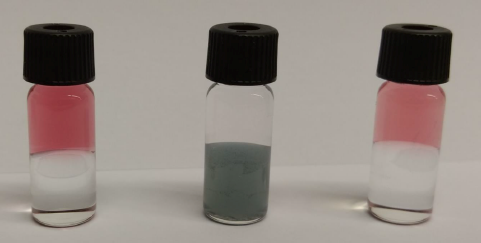
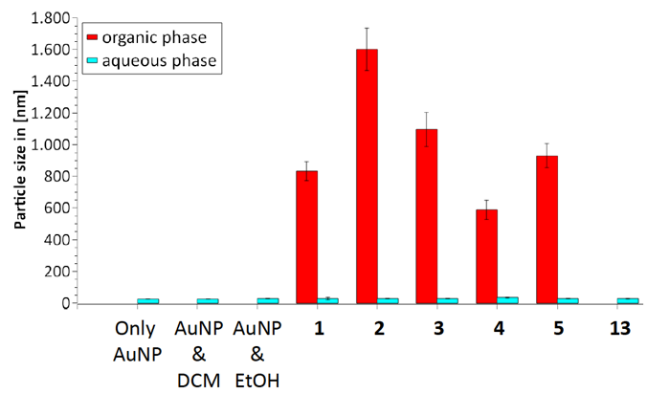
References
Our general approach to molecular wires:
Djawed Nauroozi, Clemens Bruhn and Rüdiger Faust*: “Diethynyldiazafluoren-9-ylidene as a π Cross-Conjugated Platform for Redox Active Transition Metal Fragments”, Organometallics, 2019, 38, 2553.
This work:
Gero Grunewald, Sebastian Greve, Clemens Bruhn and Rüdiger Faust, in preparation.
Prof. Dr. Rüdiger Faust
full member
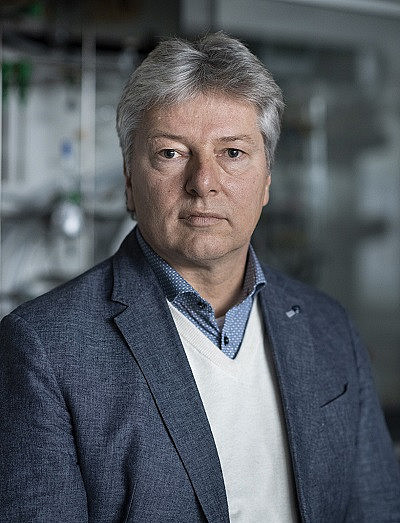
- Telephone
- +49 561 804-4750
- R.Faust[at]uni-kassel[dot]de
- Location
- Universität Kassel
Fachbereich 10 - Naturwissenschaften & Mathematik
Institut für Chemie
Heinrich-Plett-Straße 40
34132 Kassel
- Room
- 3167
